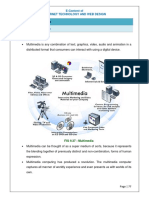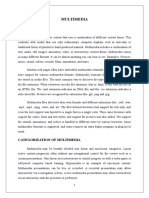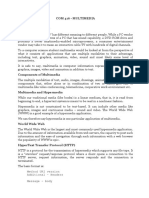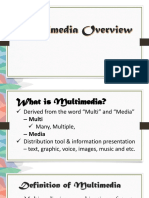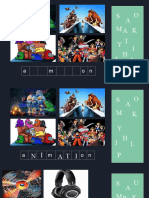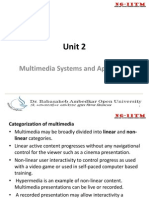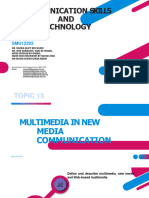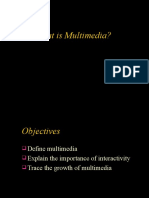WERABE UNIVERSITY
Institute of Technology
Department of Information Technology
Chapter 4: Multimedia Basics & Representation
Overview of multimedia and multimedia systems:
Multimedia can be defined as any application that combines text with graphics, animation, audio,
video, and/or virtual reality. A computer system is a combination of equipment (hardware),
processes and programs (software), and people organized to perform a function.
Why multimedia:
Multimedia is a broad term for combining multiple media formats. Whenever text, audio, still
images, animation, video and interactivity are combined together, the result is multimedia
Types of media:
News media (earned media)
News media takes mass media elements and uses them to deliver news to a target audience or the
general public. It’s any material or content that is written about you or your company that you
didn’t create or pay for yourself. For example, your company can earn a story in Forbes as
opposed to paying for advertising. In today’s world, earned media can come in a variety of new
forms, such as being featured in a review (even bad yelp reviews) or through a tweet about your
business that was liked and retweeted.
Social media (shared media)
Social media is a digital tool, such as a website or app, that allows users to quickly and easily
create and share content with the public. It’s the “evolving” media because the definition of it is
constantly changing. Shared media is best defined as content posted to social media regarding
your brand, such as posts on Pinterest, Twitter, Instagram, Facebook, and LinkedIn. This is also
known as the most cost effective platform for PR.
Web media
Web media is a form of communication that uses audio, text, and visuals on the web. Some
examples of web media are videos, photos, and graphics. It’s content you own by personally
creating it.
1
�Some examples of owned content that are popular today include podcasts, websites, blog posts,
and videos. Owned media can also be content your employees created as long as that content is
put into a contract signed by both parties.
Print media
This is the media that your parents grew up with, and it’s still around today. Also known as
traditional or even “old-fashioned” media, print media includes magazines, newspapers, books,
and comics. In more recent years, print media is used with desktop publishing software and
electronic book reading technology, such as the Amazon Kindle.
Other forms of media
Television is a form of entertainment that has been catching the attention of Americans for more
than fifty years. Originally, there were limited options for TV channels, and audiences had to
watch programs at a specifically broadcasted time. Now with streaming apps, you can watch a
variety of movies and television shows on demand. Movies are the oldest form of entertainment;
back in the day, you could only watch movies at the theater. But now with new technology, you
can stream or rent movies to watch on the television, your phone, or the computer.
Video games have been available for purchase since the 1980s. Now with life-like graphics,
advanced processors, and highly realistic simulations, you can feel like you’re in the game. If
you want to learn how to reach a certain audience, video games are a great way to do this. Video
games are promoted by the media, and they are targeted to specific audiences. A business can
create a product for a video game that includes a message that targets mass audiences.
Image formats and color models:
An image could be described as two-dimensional array of points where every point is allocated
its own color. Every such single point is called pixel, short form of picture element.
Image is a collection of these points that are colored in such a way that they produce meaningful
information/data. Pixel (picture element) contains the color or hue and relative brightness of that
point in the image.
Video formats and color models:
Video formats
The AVI Format
The AVI (Audio Video Interleave) format was developed by Microsoft.
The AVI format is supported by all computers running Windows, and by all the most popular
web browsers. It is a very common format on the Internet, but not always possible to play on
non-Windows computers.
2
�Videos stored in the AVI format have the extension .avi.
The Windows Media Format:
The Windows Media format is developed by Microsoft.
Windows Media is a common format on the Internet, but Windows
Media movies cannot be played on non-Windows computer without an extra (free) component
installed. Some later Windows Media movies cannot play at all on non-Windows computers
because no player is available.
Videos stored in the Windows Media format have the extension .wmv.
The MPEG Format:
The MPEG (Moving Pictures Expert Group) format is the most popular format on the Internet. It
is cross-platform, and supported by all the most popular web browsers.
Videos stored in the MPEG format have the extension .mpg or .mpeg.
The QuickTime Format
The QuickTime format is developed by Apple.
QuickTime is a common format on the Internet, but QuickTime movies cannot be played on a
Windows computer without an extra (free) component installed.
Videos stored in the QuickTime format have the extension .mov.
The Real Video Format:
The Real Video format was developed for the Internet by Real Media.
The format allows streaming of video (on-line video, Internet TV) with
low bandwidths. Because of the low bandwidth priority, quality is often reduced.
Videos stored in the RealVideo format have the extension .rm or .ram.
Color models in video:
• Video Color Transforms
Largely derive from older analog methods of coding color for TV.
Luminance is separated from color information.


